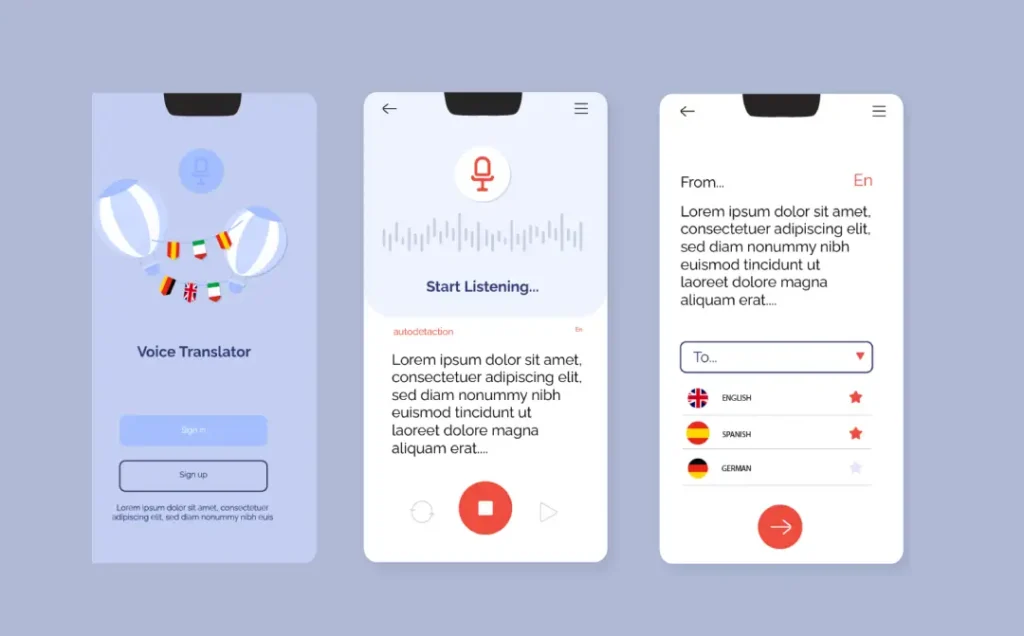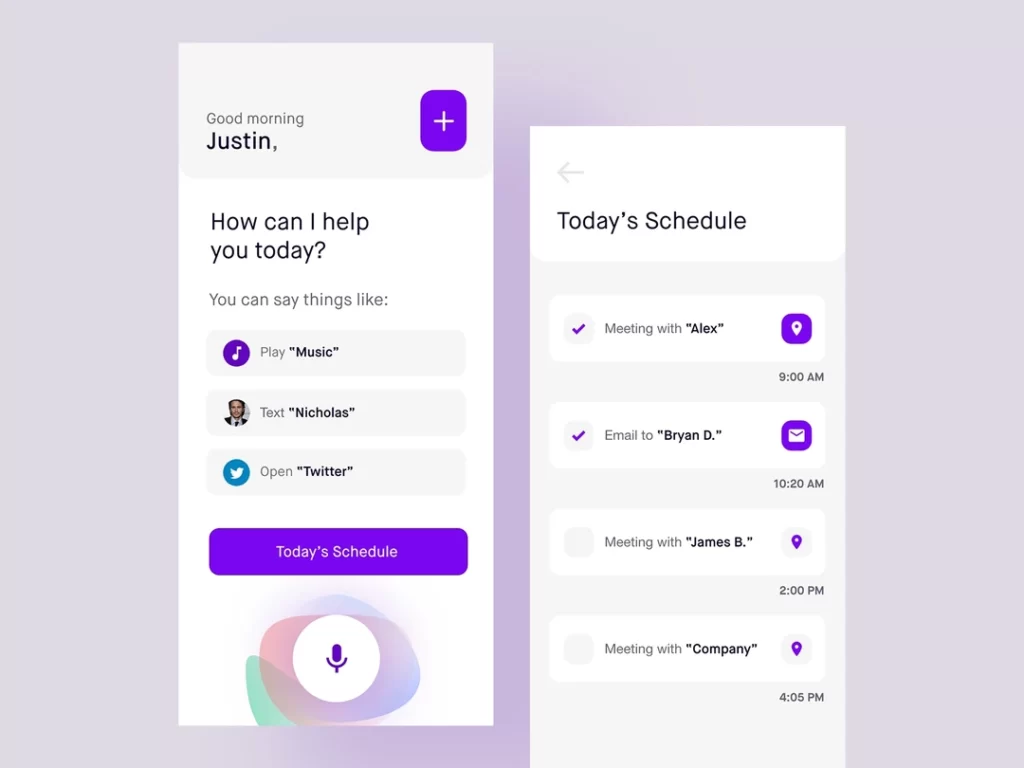Voice User Interface Design: Designing for VUI Systems
These days, voice-activated systems are becoming very popular and flooding the market. Designers should now learn how to design voice user interfaces for mobiles and voice-controlled devices.
User experience design is a field that changes very quickly. Innovative technologies have been introduced, with new devices coming in frequently. Because of this, the interaction between users and physical or digital objects has wholly changed. With the latest touchscreen technology, even digital products can be easily operated.
Many advanced forms of technology have made us use voice commands more often than before. Many people know it because Google Assistant, Alexa and Siri allow them to interact through their voices, which takes user experience to another level.
Voice-use interfaces enable voice interaction and encourage user interface experts to pay attention to this user experience.
Let’s discuss creating voice user interfaces and some benefits and trends related to designing interfaces for devices activated by speaking.
- Voice User Interfaces (VUIs) enable seamless interaction with devices using voice commands, enhancing user experience and accessibility.
- VUIs promote hands-free operation, allowing users to multitask safely during activities like driving or cooking.
- Feedback and error handling are critical in VUI design to ensure users are informed and can recover from misunderstandings.
- Natural Language Processing (NLP) and speech recognition are essential technologies for creating effective VUI systems.
- Diverse applications of VUIs span industries, significantly improving user engagement in fields like healthcare and retail.
What are Voice User Interface Designs?

Voice user interfaces (VUIs) were created to enable people to interact with devices, applications or services using voice commands or natural language processing. VUI design makes users' experience smooth and familiar through speech recognition technology.
Perhaps the most remarkable thing about a voice user interface design is that it allows interaction with digital products or systems while doing something else – without touching anything.
The technology used in voice user interfaces is based on the fact that they can recognise speech. This means you can talk to your device just as you would to anyone else.
Designers need to embed conversational user interfaces within their existing user interfaces not to confuse their target audience but to create an environment where they will quickly get along with it.
Importance of Voice User Interfaces (VUIs)
In this competitive world, businesses must keep up with ever-changing technologies to remain relevant. One such technology causing waves across various industries is voice tech, even though it has existed for some time.
Many leading companies, organisations and well-known brands in different industries have incorporated this incredible invention into their systems, including websites, mobile apps, voice assistants like Siri or Alexa, and wearables like watches and TVs!
Some examples include the Samsung SmartThings Hub, which uses Zigbee wireless protocol. At the same time, the Google Home Mini smart speaker serves as an entertainment hub for IoT devices such as light bulbs, controlling them wirelessly via Bluetooth Low Energy (BLE).
Google reports that 20% of people use its app's ‘voice search’ feature. In comparison, almost 71% would prefer typing because it’s much faster, according to recent research by ComScore on behalf of Google themselves!! Today, there are mobile apps galore, so why not add VUIs?
Benefits of VUIs

Voice user interfaces are essential to modern technology and user experience design because they have many benefits. Today, businesses are incorporating VUIs into digital products more and more to ensure high user engagement, provide memorable UX and keep up with the times. Here’s a list of what voice user interface designs bring about:
Natural Interaction
These interfaces understand human conversation since they can process natural language and speech, enabling users to interact with devices, applications and services using these mediums. This type of interaction can make technology easily accessible to wider audiences, even those who are not tech-savvy or don’t know much about conventional input methods such as keyboards and touchscreens.
Hands-Free and Eyes-Free Operation
With VUIs, people can carry out tasks without using their hands or eyes. You can do anything while driving, cooking or working out with a VUI since it doesn’t require hand-eye coordination for most activities; hence, this feature promotes safety and convenience.
Accessibility
Visual or physical disabilities do not affect the use of VUIs; they are designed so that every individual, regardless of their ability, can operate them. Voice commands act as alternative input methods that may be simpler for persons with disabilities who find traditional interfaces challenging to use.
Efficiency and Productivity
Compared to manual input methods, voice commands enable faster execution of actions by streamlining interactions or tasks so that users can complete them more quickly and efficiently. For example, typing messages on keyboards or touchscreens is slower than dictating messages through voice commands when setting reminders.
Multimodal Interaction
In addition, designers could create multimodal interfaces by combining touch/gesture with VUIs, thereby making it possible for different types/sizes/weights, etc., where some might be easier than others depending on factors like ease of reachability etc., thus allowing users choose what suits best leading to versatile user experience.
Personalisation and Context Awareness
The most advanced VUIs utilise state-of-the-art NLP (Natural Language Processing) technologies coupled with ML (Machine Learning) algorithms for understanding user behaviour, intentions, and contexts. Therefore, they can offer personalised responses and delightful engagement, leading to substantial interactions.
Integration with Smart Devices and Services
Usually, VUIs will be combined with virtual assistants, smart devices, or online services to control appliances at home through voice commands and access information from the internet using speech-based inputs while performing various tasks. This integration makes it easy for people to interact seamlessly across different platforms and devices.
Innovative Applications
Healthcare is one area where VUI has brought about significant changes. Still, other sectors, such as the automotive industry, retail sector, and customer support, have benefited dramatically from these interfaces, which can enable shopping by talking. For example, clinical documentation can be done faster through voice-enabled systems.
At the same time, patients become more engaged through having their voices heard during consultations, thus leading to improved outcomes, especially when dealing with chronic conditions like cancer, where long periods of treatment may require frequent visits.
What Components Should Designers Consider When Creating A Vui Design?

VUI design is intended to develop intuitive, intelligent, and pleasant systems with which to interact. This approach will enable users to accomplish tasks using natural language and voice commands, whether creating a VUI for a smartphone, wearable device, virtual assistant, sound system, or TV device.
There are many points you need to have in mind when developing these voice interfaces. To achieve the quality of end-user experience design, a thorough implementation and step-by-step tweaking are required to create compelling voice interfaces. A successful user experience design will be ensured if all components are implemented carefully.
Speech Recognition
It is one of the most crucial components of a VUI as it entirely relies on speech recognition technology to interpret and understand the user's spoken commands or queries. This advanced technology converts spoken commands into text so the system can quickly process them.
Thanks to different specialised software tools and advanced programming languages that can easily manage voice speech recognition. The ultimate goal is to create a VUI that recognises and understands human voice, ready to pick up a voice command and respond immediately upon receiving.
Natural Language Processing (NLP)
NLP, indeed, is one of the most innovative technologies, and the most important thing about it is that it enables machines to comprehend spoken language. NLP can make the voice recognition process easier. This is necessary to recognise voice commands, extract the suitable data to be reapplied and then generate a proper response.
Dialogue Design
VUI designers create dialogues that are divided into asking the users for specified information and instructing them through the interaction with the system. This step includes creating the dialogue, determining the customer responses, and determining the greeting and error messages if the process is interrupted.
Persona and Tone
VUIs often have a persona or personality that reflects the brand or purpose of the system. Designers decide what kind of tone and language is suitable to interact with users and how to employ it.
Error Handling
Correct error handling is vital to VUI design to ensure users can overcome misunderstandings and uncertainties smoothly and composedly. In such cases, a VUI should generate error messages in an unambiguous format, suggest how the mistake should be corrected, or repeat instructions.
Feedback and Confirmation
This is the most critical component of a voice user interface design system that keeps the conversation flowing smoothly with humans. An intuitive VUI hears the voice command and understands the tone, resulting in a prompt response that aligns with the spoken words.
VUIs should provide helpful feedback to users to let them know whether their commands are recognised and carried out correctly. The available devices can provide auditory or visual feedback, such as beeping and vibrating.
Multiple Input Styles
In some circumstances, the VUIs could allow the users to engage in the multifunctional interaction approach where users can use multiple input styles such as touch and muscular movement.
Accessibility
When creating a VUI, designers must keep accessibility requirements in mind to ensure the interface is easily usable by disabled people. Make sure to create an interface that allows visually impaired users to use the interface.
How to Design a Voice User Interface Design?

How to create a voice user interface design? How do you create memorable user experiences for voice-activated systems? These are the most critical questions that come to your mind if you are new to designing and haven’t designed it before.
Many businesses now consider embracing voice technology and creating digital products with voice navigation. That is why the demand for UI/UX designers and app developers who can build games and mobile apps with better voice interfaces has significantly increased. Designing voice user interfaces is more challenging than it sounds.
Many UX designers and app developers find it challenging yet exciting to create VUI designs that create better customer voice experiences. It would be best to keep user expectations for voice user interfaces in mind as they associate voice-activated devices like talking to others. To create great user experiences with voice interactions, it is essential to understand how to make better voice user interfaces.
Understand Your Target Users
Understanding your target audience is crucial for creating a successful VUI like any other user interface. Before starting the voice user interface design process, understand what your target audience wants and how they will interact with your voice-based product. Consider their demographics, preferences, language proficiency, and any limitations they might have.
Understanding your target audience’s problems and researching potential users can give your development team valuable insights for building a successful application. It is a great strategy to save the cost of mobile app development.
Identify the user persona and determine their needs, behaviours, and motivations. Carefully think about where you can implement voice technology in the user flow and how voice interactions can improve the user experience.
Identify the problems/questions customers frequently ask via live chat and social media. Integrating this conversation during a customer journey is a sensible approach to delivering a positive UX.
Perform Competitor Analysis
Performing competitor analysis will give you a clear idea of what your competitors are doing and how they integrate voice technology into their apps and digital products. For instance, you can search for what type of voice commands they use for interactions.
Check their product reviews to identify their positive and weak areas. Conducting a VUI competitor analysis will help you develop creative ideas for your interface design.
Gather Requirements to Solve Pain Points
After performing audience research, defining user persona, and conducting competitor analysis, you must collect user requirements to create a better voice user interface app. You can create polls, quizzes, and discussion groups and follow some user testing methods to collect users’ requirements.
These findings will help your UX design and developer team to create a conversational UI by keeping this valuable data in mind.
Understand the Anatomy of Voice Commands

Creating a dialogue flow for VUI is essential to provide more accurate results. A clear understanding of voice commands can help designers create a better interface design. Your design team should know the goals users are trying to accomplish with the digital product. The team needs to understand the essential components of the voice command—intent, utterance, and slot.
Try to keep the dialogue flow conversational. It is advised to design your VUI to mimic natural human conversation. Use language that is simple, concise, and easy to understand. Avoid jargon or complex terminology unless it's necessary.
Clearly Show Users the Available Options
One of the biggest challenges UX design teams face when designing voice user interfaces is that there needs to be a way to show the available options. It all relies on the conversation. To overcome this challenge, you can provide users with all the possibilities for positive interaction. Inform users about the functionality or feature they are using.
Remember, users have no visual guidance, so try to use examples and full intentions to demonstrate how to get an accurate response. This way, users will make the most of every feature.
Keep Information Short to Avoid Confusion
Unlike graphics user interfaces, users can’t be able to check different categories or lists. Forgetfulness and frustration are the significant issues users face. Keep the verbal content concise and meaningful to solve this issue and ensure better interaction.
Avoid offering long menus or category listings, as providing much information will overload users. Give the most popular options first if you have different groups or options. Ask users if they want more options to fulfil their goals quickly.
Provide Feedback
Providing clear and timely feedback is essential since users can't see the interface. Use auditory cues such as tone of voice or sound effects to acknowledge user input and indicate system status. Your users must be informed when the VUI interacts by giving them cues that the assistant is listening to their commands. When the task is completed, tell them that the task is done.
Design for Error Handling
Every voice user interface designer is advised to create a design while considering possible errors. Users make mistakes or come across errors while interacting with a VUI. Consider the possibility that the voice assistant doesn’t understand the user’s commands. In many cases, AI can't interpret the information the user provides.
Mispronunciation, mishearing, and microphone quality are a few reasons for misinterpretations. To fulfil the objective of the interaction, an AI assistant requires more information to deliver precisely what the user wants. Design robust error-handling mechanisms that help users recover gracefully from errors without getting frustrated.
Testing is Important
Testing your VUI is an excellent strategy to launch a successful digital product that fulfils every goal you have set. Create different groups of target users and implement testing sessions to check how users interact with the dialogue flow. Perform usability testing with users to determine any issues or areas for improvement in your VUI design.
Use feedback from testing to iterate on your design and make modifications as needed. Many mobile app testing tools will help you track task completion and customer satisfaction scores.
Finding Voice User Interface (VUI) Design Jobs

As technologies based on voice recognition become more widespread and implemented into different domains, the opportunities for VUI designers have increased dramatically, providing numerous jobs and career prospects for professionals with experience in voice interface design.
Nevertheless, the opportunities for acquiring VUI designer jobs have been relatively emerging in recent years and, thus, can be considered a promising and well-paid career option for VUI designers.
- Yulys is an incredible job search application that helps you find the job you always wanted and allows you to connect with your future employer. It does not matter if you seek an on-site job or if you search for a remote job. Yulys can aid the job-seeking process and help you apply for jobs relevant to your experience, skills, and pay grade.
- HireBasis is another excellent choice for VUI designers, allowing them to find online jobs. The platform focuses on skills-based hiring (SBH) and worldwide remote job hiring. The platform is an invaluable resource for finding remote talent from more than 100 countries. The advanced search feature makes it simpler to find the right job according to your skills.
- Flex Jobs is a tremendous job-seeking platform that allows candidates to find high-paying remote jobs in career-oriented fields. You can browse and apply to expert-verified jobs near or anywhere globally. Flex Jobs has high-quality job listings; from entry-level to executive level, startups to Fortune 500, you can find one with advanced remote search filters.
- WeWorkRemotely is the best place to find incredible remote jobs. Candidates can easily find their dream job at the best remote companies in the world.
Concluding Thoughts
Integrating voice user interface designs into digital products is a sensible approach to supercharge user experience and make the most out of it.
From fostering natural interaction to increasing accessibility, efficient operation and maximum engagement, the advantages of creating VUIs are limitless.
Following the standard guidelines helps UI/UX designers create an intuitive VUI system that offers excellent value to tech users and addresses their ever-evolving needs, ensuring continued success.
FAQs
What is a Voice user interface design?
A voice user interface (VUI) is the latest technology, allowing users to interact with a system or device using voice commands or natural language. A VUI can perform many tasks: shopping, playing music, doing an online grocery, switching off lights, setting reminders, or getting real-time weather updates.
What are some famous VUI device types?
The most common types of VUI devices are smartphones, wearables, virtual assistants, sound systems and TVs.
What are the pros of voice user interface (VUI) designs?
Voice user interface design is a breakthrough technology that offers many unique benefits. Incorporating this technology into the UX design process will ensure maximum user engagement. There are some benefits of designing voice user interface designs.
· More flexible interaction
· Eye-free and no physical limitations
· Keep your product competitive
· Easy to use
· Encourage multitasking
· More Accessible
What are the famous VUI design examples?
· Amazon Alexa
· Google Assistant
· Android Auto
· Apple Siri
These are a few of the best VUI designs that UI/UX designers can consider when creating a voice user interface for a digital product.
How to design a voice user interface?
When it comes to creating a voice user interface design, keep the following tips in mind:
· Perform audience research and understand their problems
· Define user persona
· Write the sample dialogues
· Use a flow chart and document the conversation logic
· Provide users with all the available options for positive interaction
· Avoid offering long menu or category listings
· Provide clear and timely feedback to users
· Keeping possible errors in mind
· Implement testing sessions
Are there any disadvantages of voice user interfaces?
There are some cons of using VUIs in your digital products, including:
· Learning Curve
· Privacy and Security Concerns
· Require a stable internet connection
· Development Complexity
· The design and development costs are high
How does a VUI work?
The speech recognition technology allows users to interact with voice-activated systems, such as smartphones, wearable devices, speakers, and TVs. These devices use voice as the primary mode of interaction, with no need to touch screens. It works by processing spoken input from users, interpreting the meaning of their commands or queries, and generating appropriate responses or actions. A VUI follows these main steps to operate optimally.
· Speech Input
· Audio Capture
· Preprocessing
· Speech Recognition
· Natural Language Understanding (NLU)
· Intent Recognition
· Task Execution
· Response Generation
· Feedback and Iteration
· Learning and Adaptation
